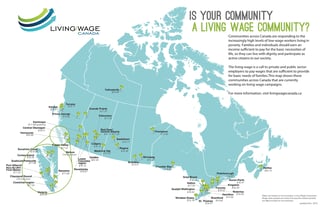At Vibrant Communities we have seen a surge in both poverty reduction strategies at a local/municipal level, as well as a dramatic rise in the number of living wage campaigns in recent years.
The crossover between our partners that are moving the needle on poverty, and those who are advocating for fair wages is clear to see in the numbers. Of our 47 full member Cities, nearly half are actively pursuing living wage policies, and have identified the living wage among their top issue-areas.
Living wage campaigns now span from coast to coast to coast, with the recent addition of Halifax, Nova Scotia's  launch, Yellowknife, NWT's launch, and Victoria, BC continuing to engage employers. In poverty reduction collective impact circles, the living wage can be a point of intersection across all four sectors. Specifically:
launch, Yellowknife, NWT's launch, and Victoria, BC continuing to engage employers. In poverty reduction collective impact circles, the living wage can be a point of intersection across all four sectors. Specifically:
- The living wage moves us away from charity towards justice and meets peoples' needs with dignity and independence
- The living wage is good for businesses' bottom line
- The living wage can help create more cohesive communities
- The living wage is able to address inter-generational poverty, by reaching Canadian children who are still increasingly living in poverty,despite at least one parent working
Poverty Reduction Strategies across Canada have been local living wage campaigns as a tool to further their economic security and employment & training objectives. Specifically:
- The living wage raises awareness about the true cost of living at a local level
- The living wage builds both individual and community capacity by improving family income
- Is linked to better quality of employment, and helps build overall local economic conditions
- The living wage is an inclusive strategy that creates healthier communities as a whole, by decreasing the inequality gap and creating engaged, included citizens
- The living wage changes our mindset towards prevention-based initiatives, in addition to moving people out of poverty
We acknowledge that living wage campaigns are one piece of the poverty reduction puzzle. We recognize that, because living wage campaigns target the working poor and their families as the main beneficiaries, and therefore do not affect people who are unable to enter the workforce or who have moved out of the workforce. But the working poor are also a much bigger portion of the population than you may realize. Between 2000 and 2005, the rate of working poor increased by 15% in Canada, and 24% in Ontario. Forty-three percent of workers are holding precarious employment in Toronto, ON, and in Medicine Hat, a living wage would benefit 6,100 full and part-time workers (1/4 of that province's working population).
In total, twenty-one Vibrant Communities- Cities Reducing Poverty members are now actively pursuing a living wage campaigns. View a complete list. Many Vibrant Communities members have strengthened their efforts by engaging businesses and the municipalities as key roundtable members or partners, enabling them to leverage living wage champions that lend credibility to the issue. For example:
- The City of Vancouver most recently became a living wage employer, affecting wages of 6,000 employees and contract workers
- Members in Toronto, ON are advocating City Council to declare the municipality a living wage employer, as part of their poverty reduction recommendations
- The Hamilton Roundtable for Poverty Reduction has engaged many local champions, including City Councillor Matt Green, who advocates on their behalf
While the narratives about people living in poverty often focuses on laziness and people who take advantage of the 'system', in reality most people living in poverty are working at least one job - often two or three, to make ends meet - and still do not have enough to pay the bills. For them, the impact of a living wage not only provides more financial security, but also offers a better quality of life for them and their entire family.
Learn More
- Join Vibrant Communities Canada's Living Wage Community of Practice - Next call: Dec. 7, 2015
- Learn more about the Canadian Living Wage Framework
- Visit the Living Wage Canada website at www.livingwagecanada.ca
- Commit your organization to Paying a Living Wage - Find Employer Recognition Programs in:





